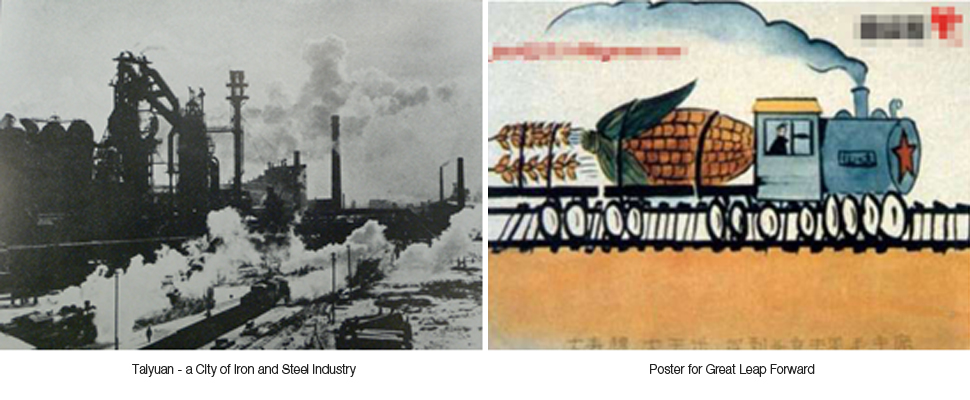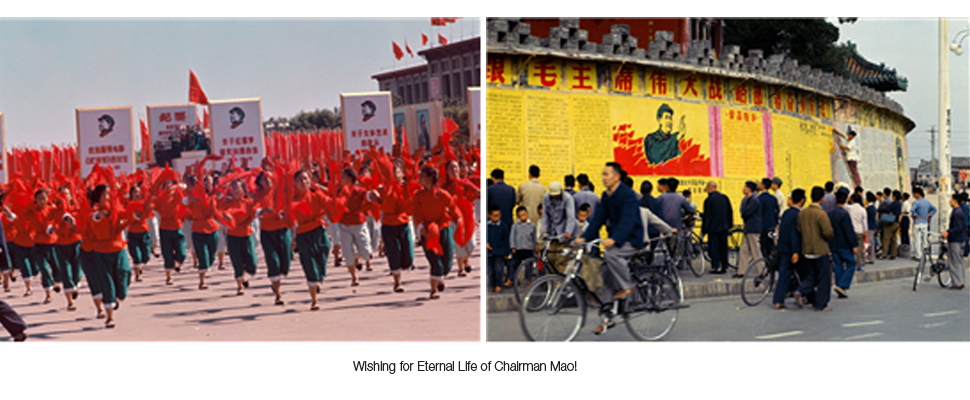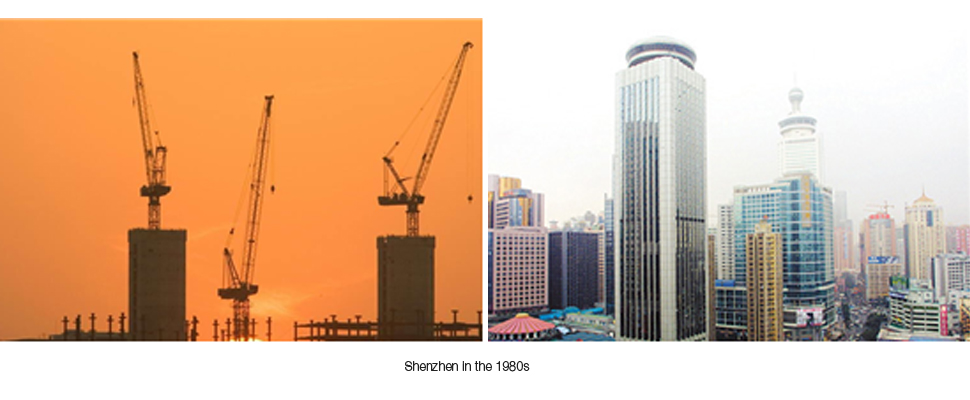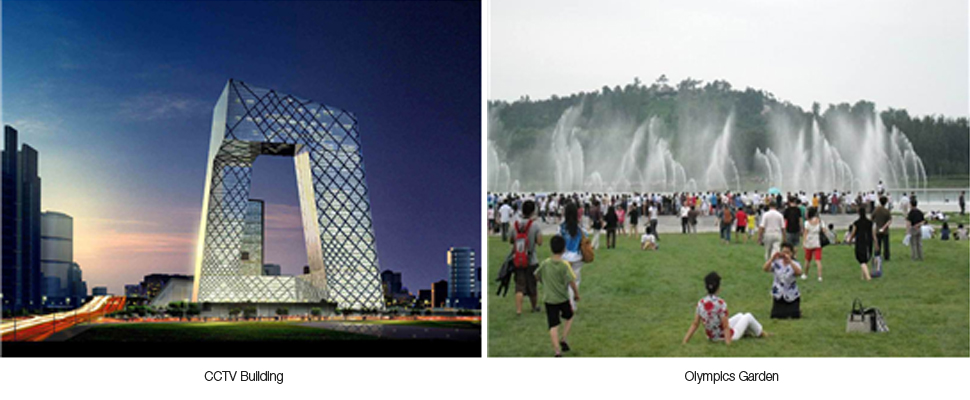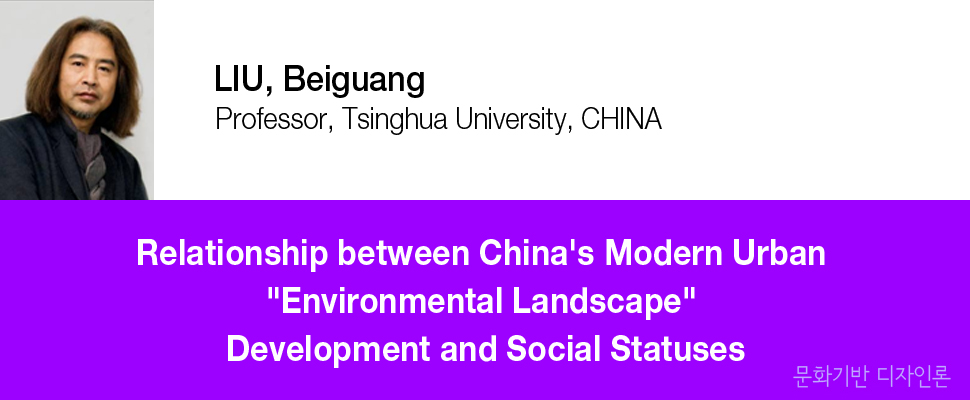
From the end of the 1940s to the beginning of the
1960s. It was the early stage of the People's Republic of China. The society
was in a status of "great leap forward". From the
middle of the 1960s to the beginning of the 1970s. It was the period of the
Cultural Revolution,a
very special period. It was a period characterized by loyalty to Chairman Mao,
going to settle down in the countryside, and class struggle. From the end of
the 1970s to the 1980s. It was the early stage of the
reform and opening, and the society was in a state of opening to the outside
world and liberation of ideology. The 1990s, the mid stage of the reform and
opening. The society was in a collision between economy and culture. At the beginning of the 21st century,
China entered the period of all-round construction of a harmonious society. The
society was on the road to harmonious development. Keywords Scene of Urban Environment, Social Status 1. First Stage: Early Stage of People’s
Republic of China (from the end of the 1940s till the beginning of the 1960s) Social Status: Great Leap Forward, Major
Social Slogans:"Go all out,aim high,and build socialism with greater, faster, better and more economic
results" "Stand on our own legs, keep self-reliance,struggle hard,and build our nation
thriftil" Major Social Background :Founding of the
People's Republic of China
On
October 1, 1949, three hundred thousand military and civil people of the
capital gathered in Tian An Men Square to hold the grand ceremony of the
founding of the state,and Chairman Mao Zedong read out the
announcement of the Central People's Government, declaring the founding of the
People's Republic of China to the whole world. It marked that Chinese history
was entering a new epoch in which the people are in power. 1.1 Scene of Urban Environment The First High-speed Development of Urban
Construction Evident fundamental changes took place in
the looks of all major cities of the country. In that period, a striking view
was "Factories' Chimneys Are Everywhere". 1.2 Scene of Urban Environment The producer-city was replacing the
consumer city All the country was in the great tide of
production and construction described as "Aiming High and Going All
Out", and the sharp increase of cities was a major representation of the
high speed development of urbanization of the period. 1.3 Scene of Urban Environment Socialistic Collective-styled Dreams and
Hopes All the society was filled with
collective-typed dreams and hopes of socialist construction, struggling slogans
took up all the major space and timeof the mass media,covering each corner of the streets and alleyways. 1.4 Scene of Urban Environment Buildings took the "National
Form" mode as the leadingmode Before the middle of the 1950s, the
so-called "National Form" was the leading mode of artcreation, which
was a continuation of the "National Form" architecture beginning from
the1920s and 1930s. It advocated enduing the new buildings with the fashion of
traditional architecture of a palace temple, for example, Beijing Friendship
Hotel has a traditional Chinese curved roof of glazed tiles. Its ideological
foundation is the stimulating impact of the idea "The Chinese people have
risen to their foot" upon the patriotic architects. 1.5 Scene of Urban Environment Period of Simplification of Chinese
Architecture From the middle of the 1950s till the
1960s,the costliness of "National Form" buildings
aroused people's attention very soon, and people were trying to correct it. But
such a correction was mostly an administrative behavior from the upper to the
lower, lacking theoretic depth,thus, for one time,
economization became the overriding trend, people gave up their pursuance for
the artistic and cultural quality of the buildings, so, many works looked very
mediocre, being basically identical with only minor differences. 2.Second Stage: Cultural Revolution (from
the middle of the 1960s till the beginning of the 1970s) Social Status :A Very Special Time,The Era
Characterized by Loyalty to Chairman,Going to the
Countrysie,and Class Struggle. Major Social Slogans: "Long Live Chairman
Mao""Free Expression of Opinion, Free Debate,and Big-character Poster" “The People's Representatives Should
Be Chiefly Composedof Worker Peasants and Soldiers" "Go to the
Countryside! The countryside is a vast world, where we can accomplish great
things!" Major Social Background: In the spring of
1968,a tide of idolization of Mao Zedong was raised in all
the country, and Mao Zedong was deified. Major Social Background: Movement of
Going to the Countryside In Dec. 1968,Mao Zedong issued
the order "Intellectual youths should go to the countryside,to receive reeducation from the poor and lower-middle
peasants". In the same year of1968, all the junior and senior middle
school graduates (three grades of 1966, 1967 and 1968, called "Old Three
Grades" later) went to the countryside. During the Cultural Revolution, the total
intellectual youths settling in the countryside were as many as 16 million, and
one tenth of the urban population went to the countryside. It was a great
transmigration from cities to the rural areas seldom seen in the modern
historyofmankind. Among the city dwellers of the country, there was hardly any
family having nothing to do with "intellectual youths" going to the
countryside. 2.1 Scene of Urban Environment Spiritual Distortion of One Decade During Cultural Revolution, a great many
cultural relics in the country were smashed, historic sites went to rack and
ruin,resulting in a great damage to the cultural heritage of
China and even the whole mankind 2.2 Scene of Urban Environment Epoch of Domination by One Person’s
Sayings Taking red revolution as belief,the whole country showed a social environment of "a red
ocean". Mao Zedong's thought became the dominant political theory of China
in the Cultural Revolution. 2.3 Scene of Urban Environment The social life was also extremely
uniform.
For
example, in all people's clothing, green, blue, black and gray remained to be
in an absolute "ruler ship", any clothing with a little flowery color
would bring condemnation as "bourgeois idea". 3. Third Stage: Early Stage of Reform and
Opening (from the end of the 1970s till the 1980s) Social Status: Open to the Outside World
and Liberate Ideology "All Cats Are Good Cats That Catch
Mice." Major Social Slogans: “Liberate Ideology,Reform and Open""Science and Technology Are First Productive
Forces""Practice Is the Only Standard for Judging the Truth." Major Social Background: In 1979,the Central Party
Committee and the State Council approved that Guangdong and Fujian could adopt
"special policies and flexible measures" in their foreign economic
activities, and decided to set up special economic zones in Shenzhen, Zhuhai,
Xiaman and Shantou, making Fujian Province and Guangdong Province become the
earliest provinces for exercising the policy of opening to the outside world. 3.1 Scene of Urban Environment Era of Multiple-architecture Theory From the reform and opening at the end of
the 1970s, architectural art began to take a healthy road,which can be called "an era of multiple-architecture
theory". With the precondition of realizing the multiple character of
architecture, people have begun to work out a newarchitectural culture with
boththe features of the times and the style of China, and many works since the
1980s are the best proofs. These excellent works fallinto many schools, roughly
being the ancientry school, the neoclassicism,the new nativism, the new
nationalism,thenative modernism and the postmodernism. 3.2 Scene of Urban Environment Free and Chaotic Life State 4. Fourth Stage: Middle Stage of Reform
and Opening (the 1990s) Social Status: Collision between Economy and Culture Major Social Background: The reform and opening up policy of the
1980s was essentially another time of learning from the West, but this learning
was not very successful, and the unsuccessful learning led toa series of grave
problems in China. In the face of these serious problems,those upholding the Western ideas thought China's learning was still
far from enough, but more people began to question and doubt such a learning
from he West. Such a doubt has cultivated the deep nationalism spirit in the
1990s, causing a sharp growth of the nationalism of China in the 1990s. 4.1 Scene of Urban Environment "Neoclassicism" Architecture
Became a Fashion in China In architecture:"Neoclassicism" became a sweeping fashion in China, and at
the same time, different kinds of building techniques and materials were
becoming sophisticated, and the architectural market was dominated by
European-styled residences, localism-styled buildings and buildings bearing
different kinds of classical symbols. 4.2 Scene of Urban Environment Architecture Got Into the Era of Hundred
Flowers Blooming Together In the later period of the 1990s,Chinese architecture entered the era of hundred flowers blooming
together. The continual appearance of works of different kinds of styles
reflected the fact that Chinese people's architectural taste was becoming
mature, and architects were turning out many excellent works by exploring into
their personal styles. After some great projects participated in the
international bidding,the latest ideas and excellent
works of the world blossomed and bore fruit in China one after another,
especially works of modernistic middle and high tech school, white school,
silver school and deconstruction school found their market in China. 4.3 Scene of Urban Environment In the slogans "Time is money"
and "Efficiency is life",in the later period of
the 1990s,expressways, urban railways, the Internet and
so on grew at a high speed. 4.4 Scene of Urban Environment
The
overspreading slogans were replaced by more and more advertisements, and the
Party andthe state's slogans began to reflect the public feelings and public
opinion more and more. The political-theory-oriented propaganda was seldom
seen, and what came instead was using the law to regulate and constrain the
governmental acts and maintaining the public interest. 5. Fifth Stage: Stage of All-round
Construction of a Harmonious Society at the Beginning of the 21st Century Social Status: Walking Towards a Road of
Harmonious Development Major Social Slogans: "Use the Law to Manage State Affairs,and Use Morals to Rule the Country"."Take the Human as the
Fundamental"."One World,One Dream"
(Olympic slogan). Major Social Background: On July 13, 2001,China won the right to host the Olympic Games of 2008. On November
10,2001, China became a new member of the WTO. The year
2008 was an unusual year for China. The 5.12 Sichuan Earthquake and the 8.8
Olympics happened in the same year, tribulation and sensation went together,
and opportunities and challenges were present at the same time. 5.1 Scene of Urban Environment In the street, in the plaza, a very clear
sense is that our civilization has "revived". Chinese people have had a more mature and
more self-confident attitude towards our owntradition and are more determined
to carry it forward 5.2 Scene of Urban Environment
People
of every walk of life are seeking a harmonious development between human and
nature, between human and society, and between people themselves. In urban
construction,the environment-friendly landscape development is clearly seen,as people are seeking a more humane environmental construction.
Everywhere we can see such urban scenes described as "Technical Olympics,
Cultural Olympics and Green Olympics". 6. Conclusion
